Alaska Fish & Wildlife News
November 2021
Captive Muskox and Exquisite Qiviut
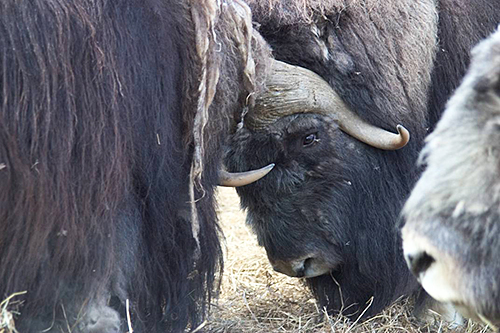
In 1930, congress gave the U.S. Biological Survey $40,000, “To acquire a herd of muskoxen for introduction into Alaska with a view to their domestication and utilization in the Territory.”
It was a resounding success in one regard, as the introduction of those muskox re-established wild populations in Alaska. Today, thousands of wild muskox roam the arctic and western Alaska thanks to that acquisition. But what about their “domestication?”
Several failed attempts to establish domestic operations, including the initial introduction, are documented by muskox researcher Robert G. White. A physiologist at the University of Alaska Fairbanks, White helped establish the university’s Large Animal Research Station (LARS), which has been a center for muskox research since 1979 and now bears his name. In 1989 he co-authored a chapter on muskox in a British text on domestication of wild ungulates. He wrote, “Muskoxen were first evaluated as an agricultural animal in the 1930s when 33 animals from Eastern Greenland were shipped to College, Alaska, by the US Biological Survey. That project was terminated after 2 years.”
When those muskox arrived at the Alaska Agricultural College and School of Mines, (now the University of Alaska Fairbanks) in November 1930, they found that the muskox “farm” was a fenced clearing in the boreal forest. Their diet included kitchen scraps and their neighbors included hungry bears. The cost of feeding and maintaining the muskox was greater than expected, fencing was inadequate, muskox broke out and bears broke in, killing some. In 1935 the entire group was relocated to more appropriate habitat on Nunivak Island in Southwest Alaska.
The open tundra of the island suited them and within 30 years they numbered more than 500. That group was the source for all subsequent wild transplants, and the next attempt at a domestic herd.
In 1964, 33 muskox from Nunivak were brought to the University of Alaska Fairbanks. But they lasted barely a decade. White wrote, “The muskox herd became too large for the Fairbanks site and was transferred to a tundra range near the mouth of the Yukon River near the village of Unalakleet in 1975-76.”
They were back to western Alaska, 300 miles north of their old stomping ground on Nunivak. But not for long.
“Within a few years, further progress at this site was precluded by overgrazing and the high costs of extending the range or providing supplemental feed in this remote location. The animals were moved to the present site at Palmer, a former dairy farm which appears to have high potential for the successful continuation of the project as it is well drained, hay production is assured, and snow depth is minimal due to moderate winter winds.”
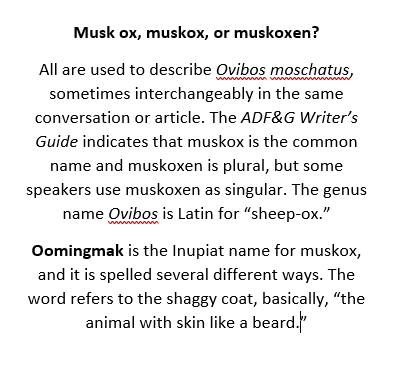
That facility, the Musk Ox Farm, is still in operation. White indicates that other ventures elsewhere did not endure. “In the early 1960s, attempts were made in Norway, Canada, and Alaska to establish an agricultural industry based on marketing of qiviut, the highly valued underwool. Although projects in Norway and Canada have been abandoned, the endeavour in Alaska remains in operation at Palmer.”
The Musk Ox Farm, a private nonprofit, is now home to 81 muskox. LARS has about 38 muskox in Fairbanks (as well as 43 reindeer and four cows). Alaska’s two herds of captive muskox offer a look at the potential for muskox as livestock. Tours and outreach are important at both facilities, as is qiviut production. Qiviut is a valuable fiber - a one-ounce skein of yarn fetches close to $100. It is extremely soft and eight times warmer than wool, by weight. It is a “fine” fiber (very small diameter) comparable to cashmere, alpaca or fine merino. It’s not itchy like wool can be, as the fibers lack the hooks and barbs that wool has. It is hypoallergenic, water-resistant, it contains no lanolin, and it doesn’t shrink.
Staff at LARS and the Musk Ox Farm shared their experiences and insights regarding muskox. But first a word on “domestication.”
Domestic muskox
Claudia Ihl is an associate professor of biology at the University of Alaska’s Northwest Campus in Nome. She’s studied muskox for almost 30 years, writing about ecological, behavioral and cultural aspects as well as biology. She worked hands-on with muskox at LARS in the 1990s.
“As a biologist, I don’t think of this as domestication, these are captive muskox,” she said. “It takes generations of selective breeding to change an animal from its wild equivalent - like with horses or cows. These are captive muskox.”
Sarah Barcalow is the lead animal technician and outreach coordinator at LARS. She’s handled muskox for eight years there, bottle-feeding calves from birth and training them to be cooperative. They want animals to essentially come when called – to bring themselves into the handling squeeze, the narrow chute where they are combed and handled, to “self-load,” and to be calm when people work with them.
“They’re not domesticated, just tame,” she said. “They are smart, they always try to move up in their hierarchy. If you are the caretaker, you are in the hierarchy even if you don’t want to be. You have to establish boundaries at a young age, so when they are 500 or 600 pounds you don’t have a problem with them.”
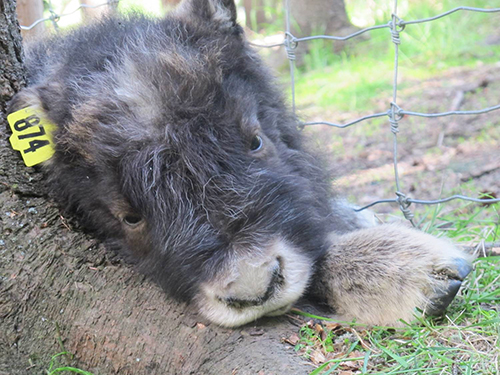
Teaching muskox requires developing a relationship over time. Barcalow said they are very visually oriented. They differentiate between men and women; they recognize individual people and treat people differently. They have distinct personalities, which makes them fun to work with.
“They are super attuned to body language - these are animals that have been around people,” she said. “They know if they know you. If you are new, you get different behaviors. They’re crafty, and they haze new people – ‘I don’t know you; I don’t need to recognize you.’ If they have the opportunity to dominate a person, they will.”
Claudia Ihl saw captive muskox treat different people differently, and in her experience, height and size mattered, particularly with regard to muskox eye-level. And anything “they don’t agree with,” they butt with their horns, she said.
“Anything small that moves quickly gets that response,” Ihl said. “One in a while a porcupine would find its way into the muskox enclosure, and we’d find it the next day, smeared all over the place.”
She thinks captive muskox are potentially more dangerous than wild muskox.
“I’ve never been charged by a wild muskox in all the years I followed them around the tundra, on foot,” she said. “A captive bull, in rut, with no fear of humans, is very dangerous.”
Barcalow said at LARS, the muskox respond better to women because the female presence has been so dominant in their lives there. She said location also influences their behavior. “Even the tame animals that are relatively good about being combed are very different outside that setting, if you are outside on foot.”
She said muskox test boundaries more than the station’s reindeer and cattle. The literal boundaries of the electric fencing.
“With the reindeer – one deer needs to touch the fence, then the whole herd knows it’s live,” she said. “Muskox, they all test it.” The energizer, the device that charges the fence, makes a clicking noise when it’s on, and the muskox know how it works. “If they hear that the clicking is not going then they’ll test it - and if it’s off they’ll push through.”
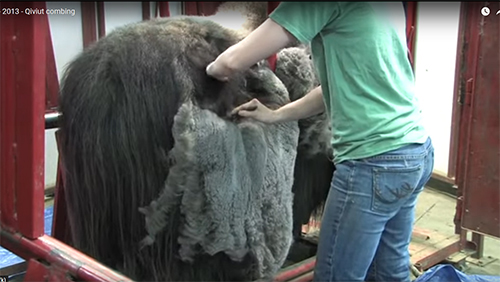
Over her eight years at LARS a concerted effort has been made to “tame down the herd,” and she can see the difference in behavior. Overall, the animals are calmer. She said she can even call a rutting bull away from cows.
“You can do better science if animals are easier to handle, you eliminate stress as a variable. Even in small animal research there is a push toward low stress handling.”
All that doesn’t make cooperative muskox domesticated.
“I don’t feel like muskoxen could be changed enough to be domesticated,” she said. “Even a baby from day one, they innately want to form a circle or that protective line when they feel threatened or nervous or spooked. They start head butting things at a young age, even if they don’t see an adult do it. I think it would be really hard to breed those behaviors out.”
“They do not behave like a cow,” she added.
Dani Biersteker is the education director at the Musk Ox Farm in Palmer. She described the muskox there as very tame. “We’re very intentional with every move we make with them, and continue to work toward tractability of the herd every day,” she said.
She also noted the importance of hierarchy to muskox, within the herd and with people, and that they key in on height and size. Dogs are not allowed on the premises as muskox can be very aggressive toward dogs. They take another step which helps manage the bulls.
“We castrate them,” she said. “It lowers stress levels, and there’s no rut, so a steer doesn’t really compare to wild muskox, it has nothing to prove. Castrating the adult males mellows them out - they still produce qiviut, they live longer, and it keeps them healthier longer.”
They have 10 viable bulls on property and two are yearlings. There are 21 steers and 50 cows. The oldest cow is 27, and one steer recently turned 24. Biersteker said 15 is old for a steer and 18 is old for a cow. Wild muskox are estimated to live 10 to 12 years.
LARS has a couple castrated bulls, but most are viable. The herd has almost doubled in the past decade. “We’ve been pushing to grow our herd, with the hope of selling animals to individuals down the road,” Barcalow said.
Muskox (captive, not wild) are on the “Alaska Clean List,” and are legal to sell and keep as livestock.
LARS was founded with muskox research in mind. Captive muskox with known histories (like pregnancies) enable researchers to make comparisons to wild muskox. Nutrition and diet, physiology, gestation, energy expenditures, behavior and herd dynamics, and qiviut production have all been studied at LARS. International researchers visit and work at the station, as well as biologists affiliated with the University of Alaska Fairbanks and the Institute of Arctic Biology.
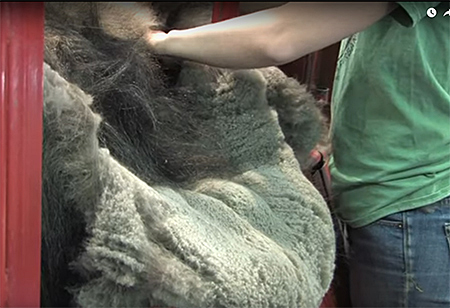
Researchers are looking at the presence of stress and reproductive hormones in hair and feces in captive muskox and comparing those to wild animals. “They’ve also been testing field equipment and methods, testing equipment before it’s deployed in Greenland,” Barcalow said. “Rumen transmitters and heart rate transmitters. It’s good they were testing them on captive animals, they had two types and one was rejected after it was installed.”
Qiviut
The Musk Ox Farm was founded with qiviut in mind as the basis of a textile fiber cottage industry. Muskox are raised as a fiber animal at the farm.
“Their life mission here is to grow hair for us,” Biersteker said. “When they start to shed naturally in the spring, we bring them into the barn and comb them out. The entire herd, from yearling to the oldest, produces on average four pounds each. The hair is sent to a mill and the qiviut is de-haired, the long guard hair, that’s like our hair, is removed. There is a secondary hair that helps the qiviut stand up, some of that is removed too, but there is still some mixed in with the qiviut. It’s a fluffy mass with almost no weight.”
Biersteker said raising muskox for meat is not profitable. It takes about three years for a muskox to reach adulthood (breeding age and close to full size). “You get qiviut every year, but you’d get meat only once,” she said. “They do produce milk for their babies, but we don’t milk muskox and there isn’t going to be a commercial milk market anytime soon. As an arctic creature that lives in a low water place, the milk is very concentrated and there’s not a ton of it. They are not like a cow.”
Executive director Mark Austin said the fiber is not sold wholesale. They sell a small amount to hand spinners, and a two-ounce bag is $55. A one-ounce skein of yarn is $95. Most is made into products such as hats, scarves, nachaq and smoke rings (a circular scarf like a neck gaiter) and sold through their shop and website.
Regarding the economics of raising muskox for qiviut, Barcalow said selling a processed product rather than fiber increases the value substantially. In their shop at LARS an ounce of raw qiviut sells for $35, and a one-ounce skein of yarn is $100. A knitted smoke ring neck scarf is $225. She said they do sell some fiber to Alaska hand spinners, and in the past, sold more qiviut to Alaska knitters, but have switched the emphasis to developing their own yarn and knitted goods to sell. “Qiviut revenue goes a long way to keeping us running,” she said.
Qiviut from Wild Muskox
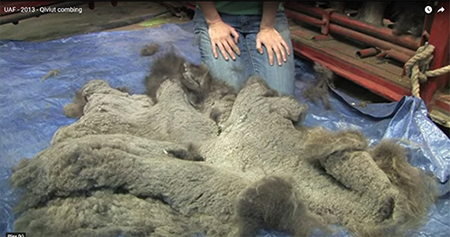
Alaskans also gather shed qiviut and comb it from the hides of harvested animals. Claudia Ihl of Nome said shed qiviut, snagged on willow bushes in thickets, is gathered in late May and June, but it needs to be collected fresh and before it gets rained on. She said it’s labor intensive, but nice sheets of qiviut can be found.
Muskox were extirpated from Alaska by the turn of the 20th century, so traditional knowledge of qiviut was lost. They were re-introduced to Nunivak Island in the 1930s, and people there (largely in Mekoryuk, the island’s community) have the longest-standing familiarity with qiviut in Alaska.
“The use of qiviut is a big deal,” Ihl said. “They get every last scrap of it off of the hides. They spin it themselves, and make scarves and hats for their own use. One thing you notice when you get off the plane in Mekoryuk, everyone wears qiviut. Hats, scarves, sweaters, gloves, baby sweaters. They also sell it for real money, several hundred bucks for each hide.”
Muskox were reintroduced to the Seward Peninsula in the 1970s; it took several decades for herds to establish so people there caught on to qiviut more recently.
Kate Person served as a state wildlife biologist on the Seward Peninsula from 1997 to 2007, based in Nome where she still lives. She wrote, “When working as the area biologist and traveling to the villages for muskox meetings I always wished I knew how to spin so I could demonstrate the potential use of qiviut. I knew that women on Nunivak Island made use of it. So many women in Seward Peninsula villages were terrific, prolific knitters and it seemed they were missing an opportunity. My very first project after retiring was learning to spin qiviut and for many years I collected, spun, knit and sometimes dyed it with lichens.”
The qiviut from hides that Claudia Ihl referenced is sold to the Oomingmak Musk Ox Producers’ Cooperative, a collective of more than 200 Native Alaskan knitters. They sell their work through the cooperative’s website and Anchorage store. The cooperative is owned by the members and served by an elected board of directors.
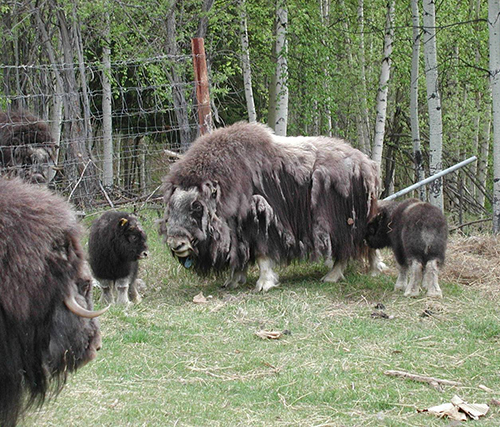
The price paid for raw qiviut varies year to year, said Hillery Baerny, the office manager at the Anchorage store and headquarters. “Right now we are buying really nice clean fiber, $11 an ounce, or $176 a pound,” she said. “We purchase our fiber from villages, gathered off the tundra or from hunters. A hundred percent of our fiber comes from the villages. Most of it comes from Mekoryuk and Nelson Island. We get a little bit from around Nome, also a little from Deering (near Kotzebue). A lot of people in Nome do their own stuff with it, so we don’t get a lot from the Seward Peninsula herd.”
The raw fiber is washed, processed and spun, and the yarn goes back to the cooperative’s knitters. Baerny said they work years ahead to ensure yarn is available. They use yarn in four weights, including one blended with silk (80/20). They favor undyed wool in the natural color.
The Future of Muskox Farming
Sarah Barcalow said that the demand for qiviut is increasing and there are not many sources of qiviut.
“There is just a finite amount of qiviut,” she said. “It could be used in more products, outdoor gear and athletic wear, if there was more available. There is a lot of potential for growth.”
Mark Austin of the Musk Ox Farm said in the past, some qiviut had been available from herds in Canada’s Banks Island and Victoria Island. “That was the only commercial source on this side of the world,” he said.
Barcalow said in recent years they’ve worked with a textile mill in Peru that specializes in very fine fibers, which are trickier to spin. Peruvians have a history with fine and superfine fibers. Vicuna, the national animal of Peru, a relative of the llama and guanaco and the likely ancestor of domestic alpacas, produces an extremely fine wool that is the most expensive natural fiber in the world. The mill is owned by Peruvian Fernando Alverez, who also owns a store in Banff, Canada, called “Qiviuk.” Its website highlights high-end garments made from muskox wool. The qiviut is sourced from Native people in Canada’s arctic who gather shed qiviut from wild muskox or comb it from hides of subsistence-hunted animals. A Qiviuk representative said he did not know of any captive muskox herds in Canada.
Another Canadian venture, “Nunavut Qiviut” sources all its qiviut from wild muskox harvested by Native hunters. They also sell yarn from the fur of arctic fox and arctic hare.
In the 1989 book chapter, White wrote, “A thorough economic analysis of these systems is lacking, but current expectations are that intensive herding systems must depend on supplementary revenue from tourism.”
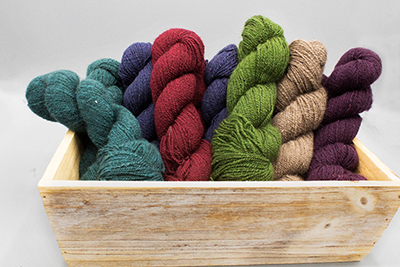
That’s certainly true with the Musk Ox Farm and LARS; retail sales and tours are important. Barcalow said LARS is open every day for tours in the summer, and they sell merchandise on site in their shop.
“I think an economic feasibility study said you’d need 30 animals to be profitable,” she said. “Agri-tourism would be a good supplement to cover the cost of feeding and housing them. Hay is the big cost, and they need a grain supplement or a mineral mixture. Hay is pricey in the state, but they are very efficient eaters.”
They offer some other advantages over most livestock. “They eat snow,” Barcalow said. “And they don’t need to be housed indoors like dairy cattle, they don’t need shelter.”
“It would be really great to see it grow,” she said. “I think the interest is there. We regularly get one or two inquires a year, sometime more, about buying animals. We have not sold any to a private entity, although we have sold some to private zoos. Our hope is to one day sell them to private individuals. It would be great to see people farm them more.”
LINKS
The Robert G. White Large Animal Research Station
Research papers on muskox via LARS
Video: Combing qiviut from muskox at LARS
More on combing qiviut
The Musk Ox Farm
Oomingmak Musk Ox Producers’ Cooperative
The Alaska “Clean List,” which specifies animals that may be legally kept as pets or livestock, includes muskox.
Qiviut production from muskoxen, Chapter 21, pp 387-400. In Wildlife Production Systems: economic utilization of wild ungulates, 1989, White, R. G., Tiplady, B. A. and Groves, P.
Subscribe to be notified about new issues
Receive a monthly notice about new issues and articles.
